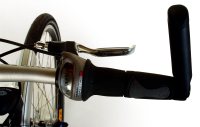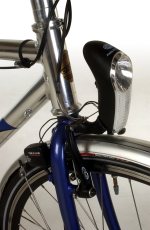The following is an extract from the CTC's "Cycle" magazine....
Chris Juden tests a thoroughly practical every day bike
In addition to all the heavy roadsters in northern Europe,
one can nowadays buy nice, reasonably lightweight but practical bikes
for everyday use. These are bikes with hub gears but many more of them;
that still have a sturdy frame, but thanks to oversize aluminium rather
than heavy steel; that still have dynamo lights but brighter and more
reliable ones, powered by the hub; that still have chain and mudguards
but tough, lightweight plastic rather than rusty, rattly steel.
For good reasons, that go way beyond the scope of this article, the British
cycle trade doesn't believe it can sell expensive bikes unless they pretend
to be sporty. Some dealers, located in islands of pro-cycling affluence
such as York and Cambridge, import de-luxe roadsters, but these models
are built for comfort rather than speed. Simon Gershon at Orbit is trying
something different. His target customer is the cycling enthusiast who
wants something reasonably quick but practical for every day journeys
to work, the shops, the pub etc.

Frame
To keep the price sensible Orbit begin with an imported frame, made to
their own design from alloy tubing. Whoever it was they did a good job.
The welds are tidy and the geometry exactly corresponds with Orbit's specification.
At this point I have to say that the model we tested was Orbit's own first
sample and that specification had not been finalised. Production will
have 1cm more mudguard clearance, another set of bottle bosses, a gear
hanger and cable guides in the right places - no plastic clips.
The frame comes in 46, 51 and 56cm sizes, also 51cm lady. We tested the
middle one, which adapted perfectly to all who rode it (men of medium
height).
The fork is steel, a sound choice for safety, and came with a generous
length of steerer so that we could vary the handlebar height for different
riders. That worked really well, by flipping the stem we got a total of
9cm height adjustment and used it! At one extreme Richard Thomas obtained
the upright visibility and control for traffic jamming around London and
at the other Greg Woodford got low and aero for his long commute. (When
you decide where you want the bars the excess can be cut off.)
We all liked the plain bright metal finish. It's practical too: you can't
scratch paint that isn't there.
Hub of the matter
 I've been a fan of the Sram Spectro-7 ever since it was launched as the
Sachs Super-7. I prefer it to Shimano because it's tough (mine is still
going strong) and gives a wider range. True, the Shimano Inter-7 has closer,
more evenly spaced ratios, but the German hub feels more efficient in
its middle range, which one uses most of the time. Another decisive factor
is the 'mini clickbox', which releases easily from the hub to allow wheel
removal without getting the hands too dirty or losing gear adjustment.
I've been a fan of the Sram Spectro-7 ever since it was launched as the
Sachs Super-7. I prefer it to Shimano because it's tough (mine is still
going strong) and gives a wider range. True, the Shimano Inter-7 has closer,
more evenly spaced ratios, but the German hub feels more efficient in
its middle range, which one uses most of the time. Another decisive factor
is the 'mini clickbox', which releases easily from the hub to allow wheel
removal without getting the hands too dirty or losing gear adjustment.
This was our first chance to ride the S-7 since Sram made the gear range
even wider and enhanced the shift. The slightly lower bottom gear was
useful. Previously extra internal friction absorbed most of the benefit
from shifting from 2nd to 1st. This friction is still apparent and it's
a fact of hub-gear life that efficiency falls the further away from direct
drive you go. (Shimano mask this effect by having no direct-drive.) Of
course, if your derailleur is covered in grime and your chain oil-free,
then a hub wins out in any gear!
 It follows that top gear is also higher, which lets us set the whole range
lower without losing the fun factor. Inch-counters will know what 31 to
95 inches means to them. I assure those who don't that it is plenty low
enough, to high enough. Personally I'd set the whole range lower, and
that's easy to do by fitting a larger sprocket (they come with up to 24T).
It follows that top gear is also higher, which lets us set the whole range
lower without losing the fun factor. Inch-counters will know what 31 to
95 inches means to them. I assure those who don't that it is plenty low
enough, to high enough. Personally I'd set the whole range lower, and
that's easy to do by fitting a larger sprocket (they come with up to 24T).
The new control has an incredibly light action. Almost too light: one
touch and it would shift right down into first, especially when wearing
gloves. But it's almost as easy to shift back and the hub doesn't actually
change gears until you've eased up on the pedals. There's no between-gears
foot spinning - there never was with Sachs - and you do not need to back-pedal;
a moment's hesitation is enough to permit the shift. Richard and Greg
immediately appreciated the freedom to shift when stationary.
 Freedom from mucky derailleur maintenance takes longer to become apparent,
but after a few days both were seriously considering internal gears. Greg
would have appreciated closer ratios for his 30-mile commute from Reading,
but didn't reckon the Orion made his journey harder.
Freedom from mucky derailleur maintenance takes longer to become apparent,
but after a few days both were seriously considering internal gears. Greg
would have appreciated closer ratios for his 30-mile commute from Reading,
but didn't reckon the Orion made his journey harder.
For the unconvinced, the Orion also comes in 18-speed or 24-speed derailleur
versions, using a Shimano Nexave 600 quality 2x9 system or Nexave 400
conventional triple, at exactly the same price on the same frame. So the
almost convinced can try hub gears with the assurance that the bike can
be converted to derailleur if they don't like it. The crank even has drillings
for two extra chainrings!
And so to the front hub: a Shimano dynamo (strictly speaking an alternator)
model, driving headlamp only via a switch with off, on and auto positions
- so the light comes on whenever you move in the dark. The lamp also has
a battery-powered diode, triggered to light for four minutes by the bulb
turning off. On or off, the hub runs very smoothly. Richard and I normally
run Schmidts, and although the numbers say that's more efficient, we can't
feel it.
To save clutter (and assembly time) Orbit fit a rear battery LED, also
an auto unit. It's good and bright and you can also leave it on the whole
time as it won't light unless the bike moves (ever so slightly) in the
dark. Richard and I still prefer a purely hub dynamo system. It's only
one more cable. A ready-made bike with such excellent lights is nonetheless
a most welcome sight.
Wheels and stuff
Moving out from the middle we have well tensioned spokes (no weakening
dish on a hub gear so they're all the same tension), deep section rims,
tough but easy rolling tyres and mudguards that in the production version
will have safety release in front. Being big enough to span potholes these
tyres also rolled nicely - Greg doesn't tolerate undue drag.
Would this bike be better with smaller wheels? No. Mountain bike tyres
may be sweeping the third world - important for adventurous tourists -
but German faith in Achtundzwanzig Zoll (28 inches) ensures 700C domination
of the European marketplace. Don't misunderstand me: 26 inches is big
enough to be really good, but bigger is often slightly better.
In production the pedals will be double-sided and connected to the rear
wheel by a corrosion-resistant chain - an excellent idea that builds on
the hub-gear advantage. A rusty chain can waste some 20% of your effort.
However I'm a bit disappointed by the chain guard. Why not a full enclosure?
I've already mentioned handlebar adjustment, which with bar-ends and the
frame geometry gives a riding position that's good for comfort and/or
speed, though the saddle is clearly devoted to the latter.
The brakes are all one expects from direct-pull. I could say that hub,
maybe disc brakes are more appropriate on a practical, low-maintenance
bike, but cost and weight count against them. These Avid/Tektro rim brakes
are excellent and a rational choice for the UK market.
The sturdy carrier supports the rear lamp and will take as much shopping
as you can pile onto it, though its fitment to the rear dropouts is not
very tidy.
A further practical bonus are the Pitlock security fasteners for the front
wheel and seatpost, that can only be turned by a special key (256 differs).
The rear wheel is secure enough - nobody steals hub gears!
Just as a leisure bike will do for everyday transport, the Orion would also be good to ride at weekends or on holiday. Yes, you could even tour on it.
Orbit have succeeded in making a practical bike that's also quick and fun. It's a bit expensive compared to the usual cheap commuter hybrid-style bike, but you get what you pay for and with this package of easy-care components it shouldn't cost anything like as much to keep on the road.
I think Orbit should do well with it and hope their dealers will give Orions some showroom space, so people who don't read this magazine get a chance to appreciate hub gears and dynamos.
Courtesy Cyclist's Touring Club